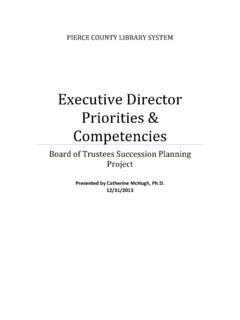Transcription of Internal Branding Best Practices Study - Odditie
1 38170_CMA_White_Cover1 5/7/07 8:18 AM Page 1. Internal Branding best Practices Study Nina MacLaverty Patricia McQuillan Hugh Oddie June 2007. Internal Branding best Practices Study Acknowledgments Special thanks to the following organizations for contributing to the qualitative research supporting this Study : American Express Genworth Financial Canada IKEA. Royal Bank of Canada Sears Canada Starbucks Canada TD Canada Trust Tim Horton's Union Energy United Way World Vision We also would like to acknowledge the support of the Executive Committee of CMA's Branding and Strategic Planning Council who first identified the need for research into brand metrics Practices in 2004, in particular, Bob Humphreys for steering the Council's initial research. Numerous CMA members have participated on the Council's Executive Committee since then, sharing their expertise and insights, and discussing Internal Branding as an important discipline.
2 Without their support, our Internal Branding best Practices Study would not have been possible. Canadian Marketing Association 2007. Internal Branding best Practices Study TABLE OF CONTENTS. Section 1: Executive Summary .. 1. 1. Summary of 1. 1. Section 2: Methodology .. 2. Section 3: Internal Branding 2. Section 4: Leadership .. 3. Section 5: Key 5. Section 6: Implementation .. 6. Internal Branding Techniques and Tools .. 6. Additional 8. Further 8. Section 7: Measurement .. 8. What is measured?.. 8. Internal Branding Measurements .. 9. Customer 9. Employee Measurement .. 10. Appendix .. 11. About Canadian Marketing 11. Author Biographies .. 11. Canadian Marketing Association 2007. Internal Branding best Practices Study 1. Executive Summary Background During the spring of 2005, the CMA Branding and Strategic Planning Council identified a need to delve deeper into Internal Branding , one of the top issues identified by Canadian marketers.
3 The Council began its research into Internal Branding with an online survey that examined how organizations view and implement Internal Branding Practices . The results, subsequently published in CMA's 2006 Fact Book, have since been supplemented with additional research. Together, they are presented in this white paper, Internal Branding best Practices Study .'. Summary of Findings Internal Branding is a relatively new approach practiced by the companies of leading Canadian brands. Given the newness of this area, it was not surprising to find that its application is relatively inconsistent across participating organizations. This emerging area of brand management presents significant opportunity to the Canadian service industry with the ability to be more attentive to Branding and customer promise development. Internal Branding also facilitates more consistent delivery.
4 Implications The successful implementation of the Internal Branding best Practices Study can build the bridge between strategy and execution. Significant improvements to customer experience and loyalty ratings can be achieved once this connection is made, assuming that an organization's brand promise is well researched and meets current customer needs. Canadian Marketing Association 2007 1. Internal Branding best Practices Study 2. Methodology This Canadian Marketing Association's Internal Branding best Practices Study is based on both qualitative and quantitative research methods. The qualitative research consisted of eleven in-depth phone interviews conducted from July to December 2006 with executives that are responsible for Internal Branding within their organizations. Contributing organizations are listed on the Acknowledgment page of this paper and are sincerely thanked for their candid and thoughtful input.
5 The quantitative research portion of this Study was managed through a CMA 2005 Internet survey of 475 respondents across industries. The CMA Branding and Strategic Planning Council provided additional input to this Study in order to reflect cross-industry experience and other recent complimentary CMA research studies. 3. Internal Branding Defined Commonly accepted definitions of either brand or Internal Branding could not be found in any of the research that has been undertaken to date. The definition of brand has become a customer experience based Therefore, it is not surprising that businesses are looking for ways to ensure that the brand experience is delivered in a way that stays true to the brand promise. But staying true to the brand promise is easier said than done. Senior management typically develops brand strategy while the actual brand experience is most often delivered by the least-informed and lowest- paid service associates.
6 Also, to further complicate matters, these front line associates are often part-time. best Practices in Internal Branding can build that crucial bridge between strategy and execution. In 2005, the CMA surveyed marketers about their organization's Internal Branding activities. Internal Branding was described within the survey as promoting the company brand values amongst employees. In 2006, qualitative interviews were conducted with senior marketers across all business sectors. These in-depth interviews revealed an expanded concept of Internal While many companies do not use the words Internal Branding , all of the interviewees were able to describe the activities that build the bridge between strategy and execution. They used expressions such as: Living the corporate values. Leveraging the corporate brand strategy to reinforce brand requirements internally and reach out to potential recruits externally.
7 Activities, processes and communication involved in empowering associates. Create and demonstrate consistent brand experience at all touch points. 1. In 2004 the CMA undertook a project to gain an understanding of how companies measured Brand . This was both a qualitative and quantitative Study , the results published in Today's Brand Measurement: The Integration of Perceptions, Behaviours & Environments, 2004. 2. The respondents included 10 senior marketers and one human resource professional. 2 Canadian Marketing Association 2007. Internal Branding best Practices Study Based on these interviews and additional reading we would suggest the following definition for Internal Branding : Internal Branding is the set of strategic processes that align and empower employees to deliver the appropriate customer experience in a consistent fashion. These processes include, but are not limited to, Internal communications, training support, leadership Practices , reward & recognition programs, recruitment Practices and sustainability factors.
8 Given the depth of information gathered through the qualitative research, this definition has been expanded with an inventory of best Practices falling under each of the processes defined, as outlined in Section 6: Implementation. 4. Leadership Who is in charge of Internal Branding ? In the research, there was not one company that had expressly dedicated one individual's responsibilities to Internal Branding ". More often than not, it was one of a laundry list of responsibilities in a marketing executive's mandate, parked alongside the responsibilities of advertising, Branding , direct marketing, merchandising, etc. One of the reasons for this lack of clear responsibility is the cross functional nature of the task. This responsibility was usually delegated to the marketing department in general. The logic for it being part of the marketing department's role is that the marketing department is the most involved in the interaction between company and customers.
9 Thus, following on from the definition, it is this functional unit that needs to join company brand with customer experience. The CMA Internal Branding Research Survey of 2005 confirms that the responsibility for Internal Branding resides within the purview of marketing: Development of Internal Branding strategies tends to be shared by the marketing group and executive team with more than one-quarter mentioning Internal Branding as a marketing responsibility and 72% stating that the executive team holds some responsibility. External agencies are utilized by one in five of the companies surveyed. Canadian Marketing Association 2007 3. Internal Branding best Practices Study AREAS WITHIN YOUR ORGANIZATION RESPONSIBLE. FOR DEVELOPING Internal Branding STRATEGIES. Marketing 77. Executive team 72. Human Resources 41. Public relations 28. External agency 21. Other 11. 0 20 40 60 80 100.
10 Percentage When asked if these were the same groups responsible for external Branding strategies, almost six in ten companies (59%) suggested that the same groups build Internal and external Branding strategies. Even if Internal Branding is nominally anchored in the marketing function, it is clear that both human resources and the executive team need to be intimately involved with Internal Branding initiatives. Notwithstanding the fact that the leadership for Internal Branding might be anchored in one functional unit, it is vital to note the importance of the role of all management to "walk the talk" and the apparent lack of them actually doing so. Only 22% of respondents in the CMA. survey strongly agree with the statement "management walks the talk with respect to brand values." Clearly there is a need for senior executives to demonstrate that it is they who are in charge, Leadership.







